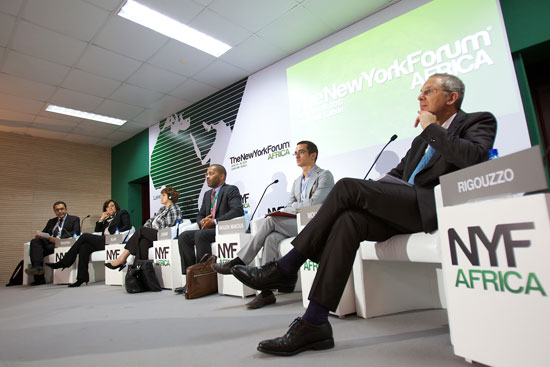FINANCING FOR SMEs: From microfinance to banks – where will capital come from?

SUMMARY PAPER
by Hannah Mansfield, School of Oriental and African Studies, University of London
Farzin Misrahi, Harvard Kennedy School
Onyekwere Ojukwu, Harvard Business School
TASKFORCE 4
FINANCING FOR SMEs: From microfinance to banks – where will capital come from?
Despite the abundance of liquidity available to finance institutions in many parts of the world, too few SMEs have access to finance that allows for sustainable growth. And for those that are fortunate enough to operate in more developed markets where they can access a share of liquidity, there is the risk of either having too little financing or becoming over-indebted due to irresponsible lending practice.
- How can banks in developing countries be flexible in their lending policies to favor SMEs?
- How can banks develop more customer-centric servicing policies and risk assessment to help nurture SMEs?
- How can we develop new products?
- What financing alternatives outside commercial banks are available in developing nations?
Speakers:
CHERIE BLAIR, Founder, The Cherie Blair Foundation for Women and Chair, Omnia Strategy LLP, United Kingdom
LATIFA ECHIHABI, Director General, National Agency for the Promotion of SMEs, Morocco
DANIEL MOUEN MAKOUA, CEO, Bwamanga Sustainable Investment Advisors, United Kingdom
TAREK MOUGANIE, Founder, Affinity, Ghana
LUC RIGOUZZO, President and Managing Partner, Amethis Finance, France
BLESSING RUGARA, Managing Director, Circle Capital Global, South Africa
Moderator:
MOURAD TAOUFIKI, Partner, McKinsey & Company, Morocco
1. Introduction: what is a SME?
a. There are many different definitions of what an SME is depending on the country,
the context and the industry;
b. SMEs struggle to get financing because their perceived riskiness doesn’t match their
actual risk profiles
c. Recommendation: each country should have a definition of what a SME is: a definition is important because it will allow banks to focus the form of credit analysis they perform
2. State solutions
a. The vast majority of entrepreneurs have unregistered assets, so they have difficulty
applying for loans because these assets cannot be considered collateral
b. Recommendation: Governments should attempt to provide mechanisms and
programs outside of traditional banking
c. Recommendation: Develop upstream aid to SMEs by developing non-financial services like advisory help and help with business plans
i. Some states have created a public/private partnership with 50/50 public/private funding in order to provide loans to organizations
ii. The central bank in Morocco has agreed to refinance the loans of commercial banks as long as they re-purpose some of the funds to SMEs
3. Non-state solutions
a. Recommendation: alter the strategies commercial banks have towards SMEs
i. Problem:
1. The current micro-finance strategy is to look at high volume small value loans; high cost of funding, high op costs = high interest rates
2. SME strategy: high value low volume loans: but SMEs want long- term loans with low interest rates; but they have a high default rate. So sit in the middle.
ii. Recommendation: Banks should go as deep as possible in their analysis of who to give loans to, rather than wide
a. This keeps cost base low
b. And decreases the default rate: capacity building, education, good governance
iii. Recommendation: Ghana at the moment gives working capital loans for the short-term e.g. 2 months because short-term, so can charge high interest rate to cover default risk
b. Recommendation: use crowd-funding techniques to tap into goodwill which can provide funding to targeted SMEs
c. Recommendation: Regulate diaspora funds with remittances from abroad:
i. Remittances are considered risk and need a platform to give money and provide financial capital.
ii. Issue is trust as people would rather give remittances to family rather than unknown entrepreneurs
d. Recommendation: use novel ways to get credit ratings
i. E.g. consumer patterns
ii. Psychometric testing
iii. Perform credit rating on a co-operative of loan receivers to build a portfolio which can have its own credit analysis
e. Recommendation: banks should get incentives from government
i. Banks could act as an agent for government money
ii. Subsidization system on loans
f. Recommendation: Large companies like Coca-Cola can provide parts of supply chain contracts to SMEs
g. Recommendation: Increase knowledge of credit officers
i. Specialist banks who specialize in agriculture and other industries
h. Recommendation: Individuals should also be prepared to start with their own capital and/or the capital from friends and close acquaintances
i. Institutions want to see that you’ve proven your model for a few years and that you also have some of your own finances in the business to prove that your business is viable
4. Nota Bene
a. In the end, funding is not a long-term solution. SMEs must have viable business models that have the ability to make money independently
TASKFORCE 4 FINANCING FOR SMEs: From microfinance to banks – where will capital come from?
1- Key statistics and trends
Small and Medium sized enterprises (SMEs) are the backbone of high-income countries’ economies, whilst they remain less developed in low-income countries (LIC). Financial access is consistently reported as one of the major obstacles to SMEs growth and development and remains disproportionately difficult for SMEs in LICs. The World Bank reports 41% of SMEs in low-income Countries recording access to finance as a major constraint to their growth and development, as compared with 30% in middle-income countries, and only 15% in high-income countries.
Access to finance through bank loans not only decreases with the level of country income, but also tends to be more concentrated among large borrowers. Whilst micro enterprises get access to finance through microfinance institutions or informal networks, a financial divide remains that has neglected SMEs, coined the “missing middle.”
The International Finance Corporation notes SMEs are important drivers of growth in economies across Sub-Saharan Africa, and account for up to 90% of all businesses in these markets. However, the African Development Bank (AfDB) report only 20% of African SMEs having a line of credit from a financial institution.
2- Recent developments
Among regions, Sub-Saharan Africa had the most reforms strengthening legal rights of borrowers and lenders in the past 8 years. The AfDB report found that a number of banks in East Africa had a significant number of clients in the SME sector and that all banks in Kenya and Zambia have created departments aimed at SMEs, while 75% of Tanzania’s banks offer the same service.
Furthermore, Dalberg identified 192 private equity funds supporting SME investment in emerging markets and developing countries with an aggregated capital of US$7 billion. Many of these funds were created in the last five years, and 60% of them focused on Sub-Saharan Africa. In addition, although still at a very small scale, the first local venture capital funds have started to emerge in developing countries.
3 - Challenges Ahead
1) Difficulties in calculating credit worthiness – and therefore interest rates chargeable – to SMEs Financial institutions need to put in place reliable and external valid credit-checking schemes which adequately calculate the credit worthiness of a SME. These credit worthiness checkers cannot be too strict; otherwise, the corresponding interest rates will be too high, constraining SMEs. On the other hand, financial institutions need to have an adequate degree of confidence that loans will be paid back, and need incentives themselves to supply more loans. Potential solutions to this could include various collateral schemes, and other insurance measures.
2) Difficulties in changing the culture/allocating greater budgets to customer service in Financial
institutions
Local banks need to be more efficient at both the front office and back office levels. Greater operational efficiency in the back office requires more personnel and training; greater operational efficiency in the front office requires more hospitality and service-based skills training. Budgetary and, perhaps, cultural constraints could provide obstacles to putting these practices in place.
4 – Opportunities for the Sector
Going forward, opportunities for SMEs on the continent will continue to grow. By 2020, analysts expect that 128 million households in Africa will have significant discretionary spending and total consumer spending in Africa will near US$1.4 trillion. By 2030, close to 50% of Africans will be living in cities and the number of middle class households on the continent will surpass China.x As previously stated, SMEs already account for much of the business in Africa--92% and 91% of all formalized businesses in Ghana and South Africa, respectively despite the current restrictions on financing.
To sustain SME growth, many have called on financial institutions to provide more resources to the “missing middle”—businesses that are too big for microfinance and too small for loans from multinational banks. However, the solutions to the lack of financing may not lie completely with financial institutions, as other opportunities are available to make financing more accessible for SMEs. For example, governments can help in providing the right conditions (e.g. clear legal standards, consistent enforcement) that encourage financial institutions to get involved with smaller African businesses. SMEs can also do more to make themselves marketable, with transparent accounting procedures and better strategic plans to present to financial institutions.
4 – Key Questions
- How can banks develop more customer-centric servicing policies and risk assessment to help nurture SMEs?
- How can banks in developing countries be flexible in their lending policies to favor SMEs?
- What are the best methods SMEs should undertake to make themselves more attractive to financial institutions?
- What is the proper role, if any, for African governments in supporting SMEs and their lack of financing?
- How will increased investment from foreign countries and multinational corporations affect SME growth and access to financing?
- What role will multi-lateral institutions like the IFC and African Development Bank play?






 BLOG
BLOG